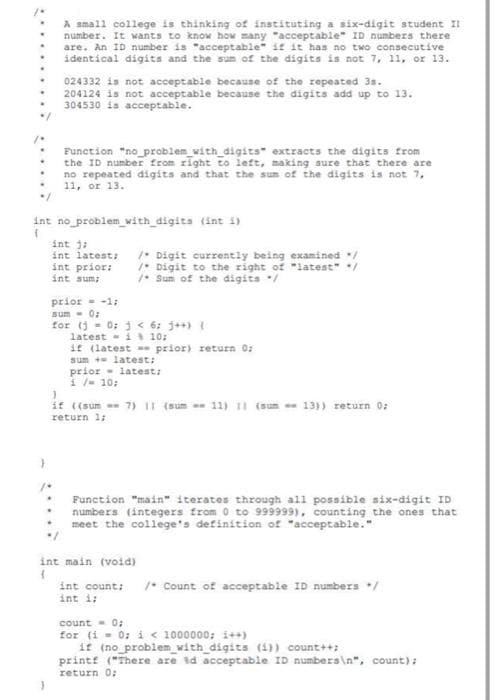A small college is thinking of instituting a six-digit student II number. It wants to know how many "acceptable" ID numbers there are. An ID number is "acceptable" if it has no two consecutive identical digits and the sun of the digits is not 7, 11, or 13. 024332 is not acceptable because of the repeated 3s. 204124 is not acceptable because the digits add up to 13. 304530 is acceptable. Function "no_problem_with_digits extracts the digits from the ID number from right to left, making sure that there are no repeated digits and that the sun of the digits is not 7, 11, or 13. "/ int no problem with digits (int i) ( int j; int latest; int prior: int sum; /* Digit currently being examined / / Digit to the right of "latest" / / Sun of the digits / prior = -1; sum - 01 for (j = 0; j < 6; j++) { latesti 10: if (latest prior) return 0; sum + latest; latest; prior £/- 10: 1 if ((sun-7) 11 (sun 11) 11 (sun- - 13)) return 0; return 1; Function "main" iterates through all possible six-digit ID numbers (integers from 0 to 999999), counting the ones that meet the college's definition of "acceptable." int main (void) 1 int count; /* Count of acceptable ID numbers */ int i; count = 0; for (i = 0; i < 1000000; i++) if (no problem_with_digits (1)) count++; printf ("There are id acceptable ID numbers\n", count); return 0;
A small college is thinking of instituting a six-digit student II number. It wants to know how many "acceptable" ID numbers there are. An ID number is "acceptable" if it has no two consecutive identical digits and the sun of the digits is not 7, 11, or 13. 024332 is not acceptable because of the repeated 3s. 204124 is not acceptable because the digits add up to 13. 304530 is acceptable. Function "no_problem_with_digits extracts the digits from the ID number from right to left, making sure that there are no repeated digits and that the sun of the digits is not 7, 11, or 13. "/ int no problem with digits (int i) ( int j; int latest; int prior: int sum; /* Digit currently being examined / / Digit to the right of "latest" / / Sun of the digits / prior = -1; sum - 01 for (j = 0; j < 6; j++) { latesti 10: if (latest prior) return 0; sum + latest; latest; prior £/- 10: 1 if ((sun-7) 11 (sun 11) 11 (sun- - 13)) return 0; return 1; Function "main" iterates through all possible six-digit ID numbers (integers from 0 to 999999), counting the ones that meet the college's definition of "acceptable." int main (void) 1 int count; /* Count of acceptable ID numbers */ int i; count = 0; for (i = 0; i < 1000000; i++) if (no problem_with_digits (1)) count++; printf ("There are id acceptable ID numbers\n", count); return 0;
Database System Concepts
7th Edition
ISBN:9780078022159
Author:Abraham Silberschatz Professor, Henry F. Korth, S. Sudarshan
Publisher:Abraham Silberschatz Professor, Henry F. Korth, S. Sudarshan
Chapter1: Introduction
Section: Chapter Questions
Problem 1PE
Related questions
Question

Transcribed Image Text:A small college is thinking of instituting a six-digit student II
number. It wants to know how many "acceptable" ID numbers there
are. An ID number is "acceptable" if it has no two consecutive
identical digits and the sum of the digits is not 7, 11, or 13.
.
024332 is not acceptable because of the repeated 3s.
204124 is not acceptable because the digits add up to 13.
304530 is acceptable.
Function "no_problem_with_digits extracts the digits from
the ID number from right to left, making sure that there are
no repeated digits and that the sum of the digits is not 7,
11, or 13.
"/
int no problem with digits (int i)
T
int j;
int latest; / Digit currently being examined /
int prior:
int sum;
/
Digit to the right of "latest" /
/Sum of the digits */
prior = -1;
sum - 0:
for (j = 0; j < 6; j++) {
latesti
10:
if (latest
prior) return 0;
sum + latest;
latest;
prior
1/= 10;
}
if ((sum=7) 11 (sum =-11) 11 (sun
un-- 13)) return 0;
return 1;
Function "main" iterates through all possible six-digit ID
numbers (integers from 0 to 999999), counting the ones that
meet the college's definition of "acceptable."
int main (void)
1
int count; /* Count of acceptable ID numbers */
int i;
count = 0;
for (i = 0; i < 1000000; i++)
if (no problem_with_digits (i)) count++;
printf ("There are 3d acceptable ID numbers\n", count);
return 0;
}
Expert Solution
This question has been solved!
Explore an expertly crafted, step-by-step solution for a thorough understanding of key concepts.
Step by step
Solved in 2 steps with 1 images

Knowledge Booster
Learn more about
Need a deep-dive on the concept behind this application? Look no further. Learn more about this topic, computer-science and related others by exploring similar questions and additional content below.Recommended textbooks for you

Database System Concepts
Computer Science
ISBN:
9780078022159
Author:
Abraham Silberschatz Professor, Henry F. Korth, S. Sudarshan
Publisher:
McGraw-Hill Education

Starting Out with Python (4th Edition)
Computer Science
ISBN:
9780134444321
Author:
Tony Gaddis
Publisher:
PEARSON

Digital Fundamentals (11th Edition)
Computer Science
ISBN:
9780132737968
Author:
Thomas L. Floyd
Publisher:
PEARSON

Database System Concepts
Computer Science
ISBN:
9780078022159
Author:
Abraham Silberschatz Professor, Henry F. Korth, S. Sudarshan
Publisher:
McGraw-Hill Education

Starting Out with Python (4th Edition)
Computer Science
ISBN:
9780134444321
Author:
Tony Gaddis
Publisher:
PEARSON

Digital Fundamentals (11th Edition)
Computer Science
ISBN:
9780132737968
Author:
Thomas L. Floyd
Publisher:
PEARSON

C How to Program (8th Edition)
Computer Science
ISBN:
9780133976892
Author:
Paul J. Deitel, Harvey Deitel
Publisher:
PEARSON

Database Systems: Design, Implementation, & Manag…
Computer Science
ISBN:
9781337627900
Author:
Carlos Coronel, Steven Morris
Publisher:
Cengage Learning

Programmable Logic Controllers
Computer Science
ISBN:
9780073373843
Author:
Frank D. Petruzella
Publisher:
McGraw-Hill Education